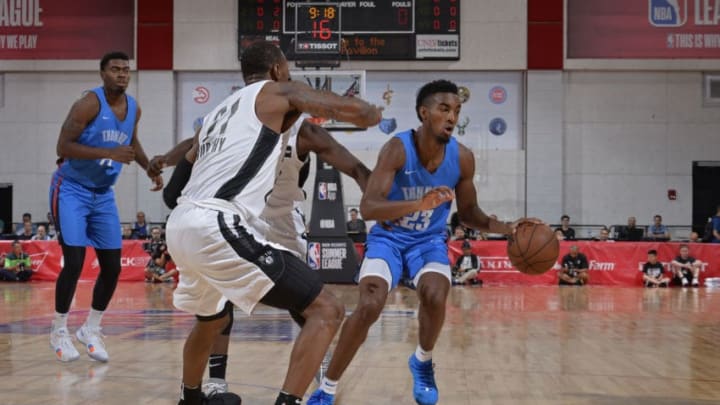OKC Thunder look to Terrance Ferguson’s growth as a playmaker in the offseason as one way the team and player can expand their offensive success.
When analyzing a player the natural instinct is to pull statistical information. More often than not statistical data can demonstrate productivity or provide fodder for a debate.. When teams determine player contracts they also point to a player’s production improvements and utilize stats as a big part of the equation.
Certainly there are other factors which play into the decisions, but statistics provide the evidence. Chemistry, team interaction on and off the court and a players willingness to play a role are also key. Although everything a player does can be tracked it’s not typical for us to immediately check to see how many screens a player set, whether they initiated a successful play, how many hockey passes they produced or if they were actively calling out switches in a game.
Those components can be the difference in wins. In the case of a player of Andre Roberson‘s ilk they might play a greater factor in determining his success. But, for players expected to produce offensively how much relevance do these components play?
Clearly, they do play a big factor in team success and a perfect reminder for this scribe came via the Terrance Ferguson article by Nick Gallo on the OKC Thunder official page. Ferguson seemed to be struggling in his 2018 Vegas Summer League , but in hindsight we focused on his offensive stats and that turned out to be short sighted.
More from Thunderous Intentions
- Stealing one player from every Southwest Division team for the OKC Thunder
- Should the OKC Thunder chase after a disgruntled hometown hero?
- 3 OKC Thunder players who can step up in Aleksej Pokusevski’s absence
- Aleksej Pokusevski sidelined approximately 6 weeks with ankle injury
- Damian Lillard does not fit with the OKC Thunder
As Gallo’s article notes, TFerg was tasked with doing a lot more in Summer League and many of those tasks were foreign to him. Arguably the biggest takeaway was the team wanting Ferguson to run the point and get down all the specifics of what that requires.
"Daigneault and the Thunder asked Ferguson to spend some time at point guard, to attack out of the pick and roll, to come off of pin down screens and to accept dribble hand offs to attack and initiate offense.The results didn’t show up on the stat sheet, as the coaches understood was likely, and there have been moments where it’s clear Ferguson was a bit frozen trying to remember everything that was downloaded into his mental playbook."
Does this mean the OKC Thunder envision Ferguson playing point in the near future? Not likely, but it does point to how the team wants the youngster to become a better ball handler and be more cognizant of the offense.
This would translate into Ferguson’s overall growth since his bread and butter up to this point was centered on defense. Offensively his role was limited to shooting open treys and running the floor for transition opportunities (usually of the dunk variety).
One area where the OKC Thunder have struggled, particularly in recent seasons is not having many players on the roster who can create their own shots or produce for others.
By engaging some of their younger assets to develop this ability it opens up the flood gates of potential for OKC’s offense.
It’s often said in season a player showcases their talent and the offseason is where they apply lessons learned, strengthen their weaknesses with a view to growth.
For the OKC Thunder, the hope is Terrance Ferguson can take his game to the next level and playmaking is clearly one area which will benefit both team and player.
